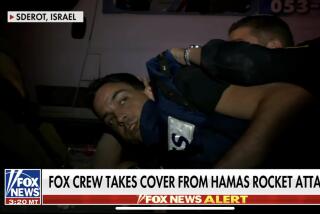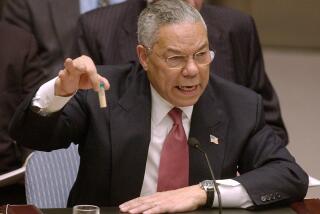News Weeklies Gun for New War Angle
- Share via
For five or six long days this month, America’s leading news weeklies were sitting ducks. They went to print during the weekend of Jan. 12-13, and then lay on the news racks, their covers pondering the likelihood of war even as America watched the allies fly thousands of sorties into Kuwait and Iraq and learned of Scud missiles thudding into Saudi Arabia and Israel.
Given production schedules, there is nothing a weekly magazine can do in such a situation. Adding to the insult, production deadlines allowed both People Weekly and BusinessWeek to beat the hard news guys to the story. On the night of Jan. 16, both publications were preparing to wrap up when war erupted. Both quickly substituted war covers and fixed the wording in war stories that were on tap.
BusinessWeek closed two hours after its usual 7 p.m. deadline. The people at People overran their usual Wednesday afternoon deadline and closed the issue at 4:30 Thursday morning. Both produced packages that are more than respectable.
Meanwhile, Time, Newsweek and U.S. News & World Report mounted a coverage blitzkrieg, gathering the reportage of the nine to 12 reporters each has in the gulf region and laying out packages of a sort that magazines are uniquely equipped to produce--and sparking a sort of spontaneous top-gun coverage contest.
“We’re one of the last places in print journalism where you have head-to-head competition,” said Maynard Parker, editor of Newsweek.
Given that coverage of this war is largely limited to those reporters and photographers in the Defense Department press pool, there is little room for competition among correspondents. The subtle victories were won in the editorial offices of the home front, where the biggest battles were fought with layout, analysis and huge, full-color maps and graphics--which all three magazines use extremely well.
Most of the best photographs, for instance, come from the pool or wire services and have already been seen in newspapers and on television: The crewman greeting his returning pilot buddy, the frightening fireworks over Baghdad.
This use of shared imagery offers an odd indication of the ways magazines can color their coverage. Perhaps the most striking photo to come out of the war, for example, shows a cruise missile roaring from the battleship Wisconsin.
U.S. News featured this eerie shot of a brilliant white streak against a bluish night sky on its cover and then again inside. Newsweek presented the same bluish shot on a three-page gatefold. Time also ran the photo. But in Time, the ghostly photo is distinctly different, an angry fire glow of yellow and red--color corrected to compensate for bad processing in the other versions, according to the magazine’s photo editor.
Newsweek comes out on top with its war coverage, devoting an entire issue to the subject, bolstering the straight pool news with history lessons, profiles of key players and important features the others don’t have: An excellent but horrific analysis of the types of injuries soldiers in the field can be expected to suffer, for instance, and the engaging--if overly macho--military analysis by a bona fide war hero, Col. David H. Hackworth, who contributed a blunt assessment of the prospects for war in last week’s issue of Newsweek.
The most impressive piece in the Newsweek package, however, is a blow-by-blow narrative of the steps leading up to the war, a “behind-the-scenes account of gross errors and deft maneuvers”--that reads like a Tom Clancy novel.
While not quite as comprehensive as Newsweek, Time’s coverage is also excellent, and Time earns points for realizing that the Soviet repression of Lithuania is of earthshaking significance, too. So Time offers fine coverage from the Soviet Union--along with a handful of discreetly selected general interest stories unobtrusively placed at the back of the book.
“There comes a point where more is not always better,” said Richard Duncan, an executive editor at Time. “The world does go on.”
True. But in the face of widespread suffering and destruction, more trivial matters must be handled with restraint--especially in the first flush of coverage.
U.S. News & World Report mixes its expanded war reportage into its standard editorial package, and the juxtaposition of such momentous matters with cheery graphics and upbeat trend stories is unseemly.
Similar tastelessness is revealed in several glib “featurettes” on what the editors apparently see as the brighter side of warfare, including such knee slappers as a soldier’s response to Saddam Hussein’s vow to fight the “mother of all battles”: “Tell him Dad’s coming to kick Mom’s butt.”
But U.S. News offers some gems, including the best overview of the terrorist threat and a hard look at whether the reserve units making up so much of America’s fighting force are up to the job. “U.S. News has learned that the Army, in a major about-face, has decided to scrap its plans to rely on reserves for actual combat on short notice in future conflicts,” it reports.
All three news weeklies approach their overviews and histories of the war as essays rather than pure reportage. U.S. News is the most unabashedly supportive, stating: “The gas masks, missiles and even Hussein’s own overwrought rhetoric seem to have done what President Bush was never quite able to do: elevate the conflict from what some critics have charged is a crass fight for oil and jobs to what it has been since August 2, when Hussein sent his troops crashing into Kuwait--a war between right and wrong.”
More than one commentator noted that although this has been the most heavily covered war in history, it is also heavily censored. Yet, most agreed that the limitations have not led to significant inaccuracies, and the important information that hasn’t been conveyed--on-the-ground reportage of the effects of the carpet bombing of the Republican Guard, for instance--could not so far have been obtained in any case.
When such reportage is available, will the magazines flinch at using it?
‘We judge everything on an ad hoc basis,” said Parker of Newsweek. “We won’t use pictures that are gratuitously violent.” But some pictures may prove newsworthy no matter how gruesome, he said.
For the most part, the news weeklies’ have had only slightly different takes on the obligatory stories emerging from this war.
Such stories include:
* The awesome effectiveness of technological warfare. All three news weeklies bombard readers with dazzling photographs and graphics detailing what the allied arsenal of planes, missiles and vehicles can do and how they work.
* Profile of a President. In all three accounts, Bush comes across as calm and courageous in the final hours leading up to the war and as the war progresses.
* The home front. We seem to have matured and grown sober as a nation, and even with the brief euphoria of the opening days, the incidents of blatant chest-thumping and jingoism were far between. Time states the national mood most eloquently: “This was a war with a long fuse. Rarely in the nation’s history have so many people had so much time to make up their mind, with so little success.”
U.S. News offers the most original insight into anti-war protests by focusing almost exclusively on what the Bush Administration thinks of the protests, rather than what the protesters have to say.
* The aftermath. No one in magazinedom doubts that America and its allies will win this war. Magazines raise considerable doubt, however, as to whether the subsequent “peace” will be an improvement over prewar conditions in the gulf region or the world.
Much depends, of course, on how the war is won, if the coalition sticks together, whether Hussein survives. U.S. News offers one unpleasant prospect: A fight to the finish might, the magazine suggests, “crush the Iraqi dictator but leave his country a smoking carcass to be picked over by Iranians, Syrians, Kurds and others whose definition of stability in the gulf may differ from that of George Bush.”
Newsweek, meanwhile, brings in Henry Kissinger to analyze the situation in his usual dispassionate style: “Ideally, one military goal should be to pull the teeth of Iraq’s offensive capability without destroying its capacity to resist invasion from covetous neighbors.”
* Impact on world economies and business. The news magazines are unanimous in their vacillation. U.S. News, for instance, first states the optimistic position that lower oil prices just may grease the economy out of recession more quickly than some skeptics believed possible. Then it explains, as do its competitors, that long war or short war, the domestic economy is still a mess--and firing all those million-dollar cruise missiles isn’t going to blow away the $400 billion deficit.
As usual, the business forecast bottom line boils down to pseudoscientific speculation. U.S. News quotes an economist who confidently notes that “the lesson of history . . . is that wars cause booms, not recessions.” But BusinessWeek states just as assuredly: “Unlike past wars, fighting in the Mideast is bad for the economy.”
* The media. From the moment CNN reporters announced that they were watching explosions in Baghdad, the news media fused with the story they were covering. The news weeklies all devote stories to this phenomenon, including ubiquitous photos of people reading newspapers and watching television.
All three news weeklies join the chorus of praise for CNN’s coverage of the war. Newsweek even repeats the quip that the war may have destroyed the networks along with Saddam’s military. It quotes TV newsman Don Hewitt’s suggestion that the three networks pool their reporters and create a network news service.
Magazine editors, meanwhile, say that the sense of competition between theirs and other media has faded. “We realized years ago that . . . our readers watch a lot of television and read a lot of newspapers,” said Richard Duncan at Time.
“Our understanding is that when they’re done, they come to us for analysis,” he adds. “A well-informed reader will have been subjected to tons of data in small chunks. We’re not competing with the deluge, we’re trying to organize the deluge.”
Overall, all three news weeklies do that extremely well.
More to Read
Sign up for Essential California
The most important California stories and recommendations in your inbox every morning.
You may occasionally receive promotional content from the Los Angeles Times.













